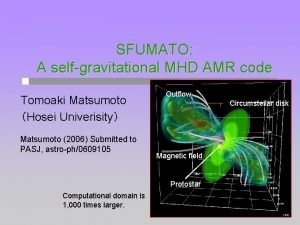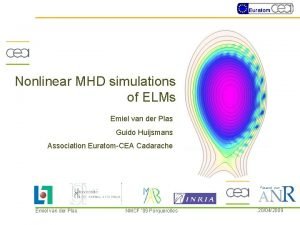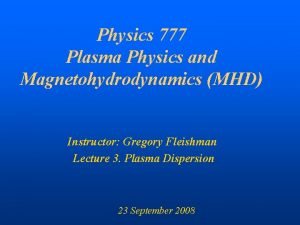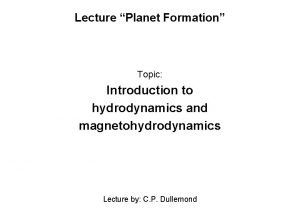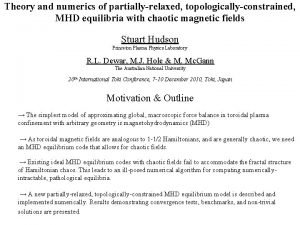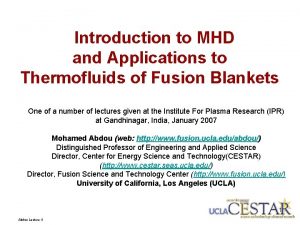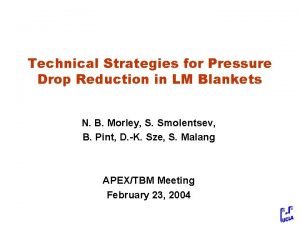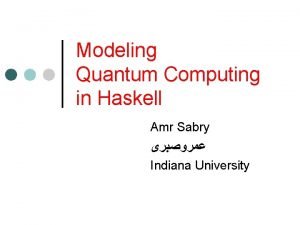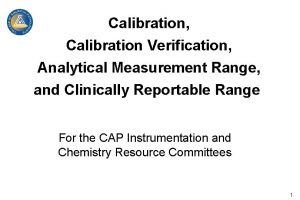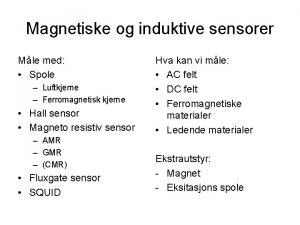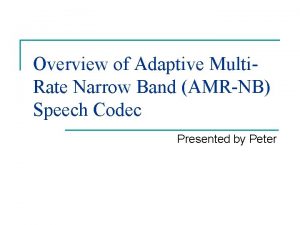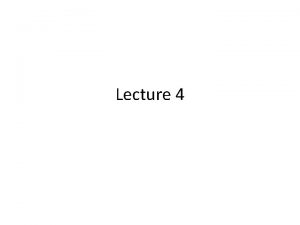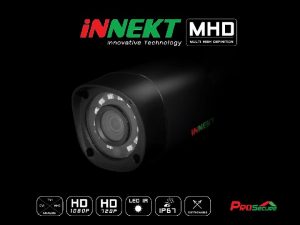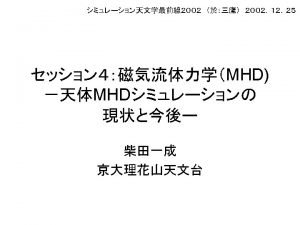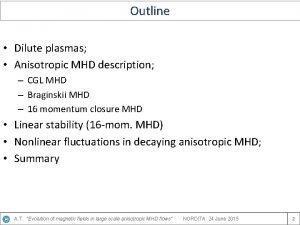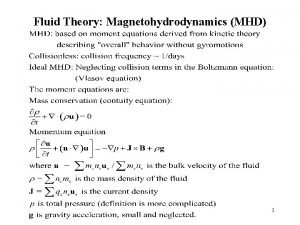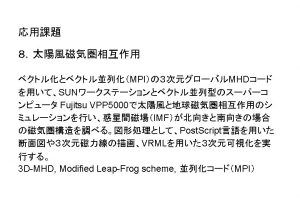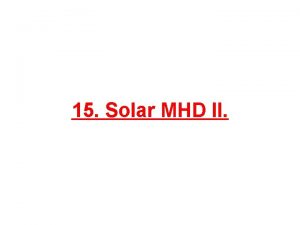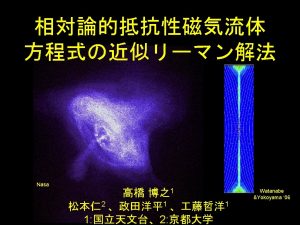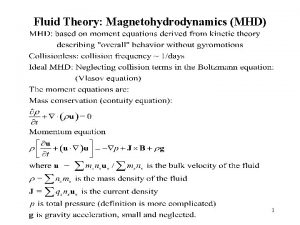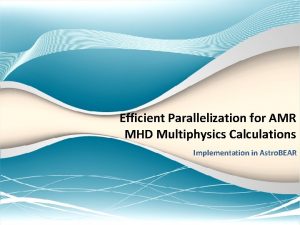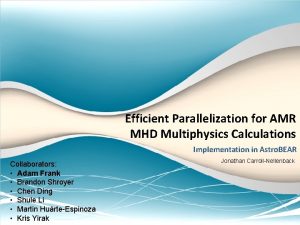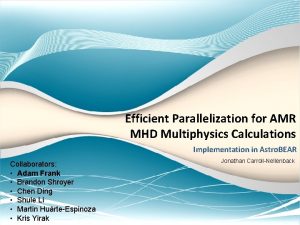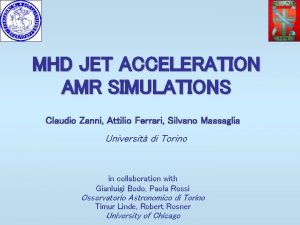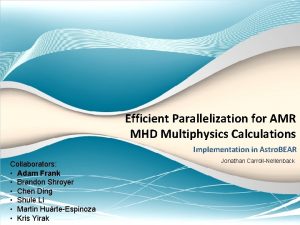SFUMATO A selfgravitational MHD AMR code Tomoaki Matsumoto


























- Slides: 26

SFUMATO: A self-gravitational MHD AMR code Tomoaki Matsumoto (Hosei Univerisity) Matsumoto (2006) Submitted to PASJ, astro-ph/0609105 Outflow Circumstellar disk Magnetic field Protostar Computational domain is 1, 000 times larger.

Introduction: From a cloud to a protostar Molecular cloud core in Taurus (radio) H 13 CO+ core Orion molecular cloud (optical+radio) Outflow and Protostar (radio)

Introduction: From a cloud core to a protostar N O I T U L O S E Protostar, R Molecular cloud core H G protoplanetary disk I H Y L and outflow E Gravitational M E R collapse T B X EB MUL TI-S CAL 0. 1 – 0. 01 pc E SI MUL ATIO 1 AU/0. 1 pc = 5× 10 N 1 -10 AU -5 First core ⇒ Second core ⇒ CTTS ⇒ WTTS ⇒ Main sequence Protostar 100 - 1000 AU

Self-gravitational Fluid-dynamics Utilizing Mesh Adaptive Technique with Oct-tree. Nested Grid, static grids AMR, dynamically allocated grids ★ ★ Developed in 2003 Matsumoto & Hanawa (2003) Matsumoto (2006) Submitted to PASJ, astro-ph/0609105 Cf. , Talks of Mikmi, Tomisaka, Machida(male), Hanawa

What is Sfumato originally denotes a painting technique developed by Leonardo da Vinci (14521519). o It was used by many painters in the Renaissance and Baroque. o The outline of an object becomes obscure and diffusive as it is located in dense gas. o Artists expressed AIR. o The code expresses GAS. o Sfumato = Smoky in Italian o NOT anagram of Matsumoto Mona Lisa, Leonardo da Vinci (1503– 1507)

Several types of AMR Level = 0 ~ 2 (a) Block-structured grid n n n Origin of AMR Most commonly used Enzo, ORION, RIEMANN, etc. (b) Self-similar block-structured grid n n Commonly used FLASH, NIRVANA, SFUMATO, etc. (c) Unstructured rectilinear grid (cell -by-cell grid) n (a) Block-structured (b) Self-similar block-structured Also used in astrophysics (d) Unstructured triangle grid n n Not used in astrophysics It takes advantage so that cells are fitted to boundaries/body (c) Unstructured rectilinear (d) Unstructured triangle

AMR in astrophysics Grid type MHD and Self-gravity are implemented in many AMR codes MHD Selfgravity Dark Matter Radiative transfer Code name Author(s) Main targets ORION R. Klein Star formation (a) Y Y N Y Enzo M. Norman Cosmology (a) Y Y Y N FLASH ASC/U-Chicago Any (b) Y Y (Y) BAT-R-US K. G. Powell Space weather (b) Y Y N N NIRVANA U. Ziegler Any (b) Y Y N N RIEMANN D. Balsara ISM (a) Y Y N N RAMSES R. Teyssier Cosmology (c) Y Y Y N ? M. A. de Avillez ISM (b) Y N N N VPP-AMR H. Yahagi Cosmology (c) N Y Y N SFUMATO T. Matsumoto Star formation (b) (c) Unstructured rectilinear (a) Block-structured Y Y (b) Self-similar blockstructured (d) Unstructured triangle N N

Summary of implementation of Sfumato o Block structured AMR n n n o HD・MHD n n n o Every block has same size in memory space. Data is managed by the oct-tree structure. Parallelized and vectorized (ordering via Peano-Hilbert space filling curve) Based on the method of Berger & Colella (1989). Numerical fluxes are conserved Scheme: TVD, Roe scheme, predictor-corrector method (2 nd order accuracy in time and space) Cell-centered sheme Hyperbolic cleaning of ∇・B (Dedner et al. 2002) Self-gravity n n Multi-grid method (FMG-cycle, V-cycle) Numerical fluxes are conserved in FMG-cycle

Conservation of numerical flux Flux conservation requires Flux on coarse cell surface = sum of four fluxes on fine cell surfaces FH is modified for HD, MHD, and self-gravity Berger & Collela (1989) Matsumoto & Hanawa (2003)

Numerical results o Recalculation of our previous simulations n Binary formation (self-gravitational hydro-dynamics) Matsumoto & Hanawa (2003) n Outflow formation (self-gravitational MHD) Matsumoto & Tomisaka (2004) o Standard test problems n Fragmentation of an isothermal cloud (self-gravitational hydro -dynamics) n Double Mach reflection problem (Hydro-dynamics) n MHD rotor problem (MHD) o Convergence test of self-gravty

Same model as Matsumoto & Hanawa (2003) Binary formation by AMR: Initial condition. Number of cells inside a block = 83 Isothermal gas 0. 14 pc Initial condition n Almost equilibrium n Slowly rotation n Non-magnetized n Small velocity perturbation of m = 3. n Isothermal gas

Binary formation by AMR: The cloud collapses and a oblate first core forms Isothermal gas Number of cells inside a block = 83 Polytorpe gas 30 AU

Binary formation by AMR: It deforms into a ring. 30 AU

Binary formation by AMR: The ring begins to fragment. 30 AU

Binary formation by AMR: A binary system forms. Spiral arm Close binary 30 AU

Binary formation by AMR: A spiral arm becomes a new companion. Companion Close binary 30 AU

Binary formation by AMR: A triplet system forms (last stage). Companion Close binary 30 AU

Binary formation by AMR: Zooming-out(1/2) 500 AU

Binary formation by AMR: Zooming-out(2/2) 2000 AU

Same model as Matsumoto & Tomisaka (2004) Cloud collapse and outflow formation Self-gravitational MHD Magnetic field lines Level 11 Level 12 Radial velocity Level 13 Density distribution

Fragmentation of a rotating isothermal cloud 10% of bar perturbation, a = 0. 26, b = 0. 16 ORION: Truelove et al. (1998) SFUMATO: Matsumoto (2006) Level = 3 - 7

Double Mach reflection problem Shock wave Wind Wall density blocks Level 0: h = 1/64 Level 1: h = 1/128 Level 2: h = 1/256 Level 3: h = 1/512 Level 4: h = 1/1024

MHD rotor problem 0. 2 Toth (2000) 1 B=5 P=1 r = 10, 1 W = 20 Crockett et al. (2005) This work pressure

Estimation of error of gravity for binary spheres Uniform spheres Level 0 Level 3 Convergence test changing number of cells inside a block as 23, 43, 83, 163, 323 cells

L 2 norm of error of gravity Convergence test of multi-grid method: 2 nd order accuracy ◇ level = 0 ○ level = 1 ◆ level = 2 ● level = 3 ■ level = 4 23 43 o o 83 163 323/block Error ∝ hmax 2 Cell width of the finest level Source: binary stars Maximum level = 4 Distribution of blocks is fixed. Number of cells inside a block is changed.

Summary o o o A self-gravitational MHD AMR code was developed. n Block-structured grid with oct-tree data management n Vectorized and parallelized Second order accuracy in time and space. HD・MHD n Cell-centered, TVD, Roe’s scheme, predictor-corrector method n Hyperbolic cleaning of ∇・B n Conservation of numerical flux Self-gravity n Multi-grid method n Conservation of numerical flux Numerical results n Consistent with the previous simulations n Pass the standard test problems
 Ansiolticos
Ansiolticos Wilson kioshi matsumoto
Wilson kioshi matsumoto Wilson kioshi matsumoto
Wilson kioshi matsumoto How to pronounce ueno
How to pronounce ueno Sfumato kurz
Sfumato kurz Sfumato sphere
Sfumato sphere Arturo sfumato
Arturo sfumato Criação de adão
Criação de adão Szibülla
Szibülla What is the difference between tenebrism and chiaroscuro
What is the difference between tenebrism and chiaroscuro Mhd
Mhd Mhd alyssa
Mhd alyssa Mhd equations
Mhd equations Mhd titel
Mhd titel Predominant cell type
Predominant cell type Mhd
Mhd Introduction to mhd
Introduction to mhd Lms fcis
Lms fcis Magneto hydro dynamics power generation ppt
Magneto hydro dynamics power generation ppt Busceral
Busceral Amr sabry
Amr sabry Icars amr
Icars amr Mysis emr
Mysis emr Pengertian fiil madhi mudhari dan amr
Pengertian fiil madhi mudhari dan amr Calibration verification linearity
Calibration verification linearity Amr induktives charging
Amr induktives charging Amrnb
Amrnb





